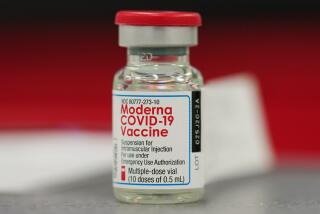A Call to Escalate the War on Cholesterol
- Share via
People at high or moderate risk for a heart attack or stroke should receive even more aggressive treatment than currently recommended to lower blood-cholesterol levels, according to new guidelines released today.
The changes, which could affect millions of Americans, include lowering the threshold at which patients at high risk of heart attack begin treatment with cholesterol-lowering drugs known as statins.
Instead of receiving treatment only if their “bad,” or LDL, cholesterol levels are 130 milligrams per deciliter or higher, they should be given the drugs at 100 or above, a panel of experts recommends.
In addition, the committee suggested a new treatment option for patients at especially high risk of having a heart attack within the next 10 years -- reducing their cholesterol levels of LDL, or low-density lipoprotein, to less than 70 milligrams per deciliter.
The recommendations, published today in the journal Circulation, were drafted by the National Cholesterol Education Program. They have been endorsed by the National Institutes of Health, the American Heart Assn. and the American College of Cardiology.
According to the American Heart Assn., 42% of heart attack victims die within the first year of their attack. Overall, nearly 1 million Americans die of cardiovascular disease every year.
The LDL level is a component of the “total cholesterol” figure that people receive from their doctors. The other component is the “good,” or HDL (high-density lipoprotein), cholesterol.
The higher the HDL level, the better. Generally, an HDL level above 60 is considered excellent.
The cholesterol guideline changes were made after several recent clinical trials showed dramatic benefits to patients given aggressive statin therapy, said Dr. Scott Grundy, director of the Center for Human Nutrition at the University of Texas Southwestern Medical Center at Dallas and chairman of the cholesterol panel.
For instance, a study of 4,162 heart-attack patients published in March reported that the risk of death was reduced by 28% when patients were given enough statins to lower their LDL levels to an average of 62, compared with a less aggressive approach that lowered them to an average of 95. The rates of additional heart attacks, strokes, chest pain and need for bypass operations or angioplasty were also all reduced in the study.
“There’s good news here -- that if we treat the right people and treat them intensively enough, we can reduce the risk of heart attack and death in a substantial proportion of the population,” said Dr. Steven E. Nissen, vice president of the American College of Cardiology and an author of one of the recent statin studies.
Statins -- a class of drugs including Lipitor, Zocor, Pravachol, Crestor and Lescol -- act to lower cholesterol levels by blocking its formation in the liver. About 11 million Americans take statins, although 36 million people probably should be on the medication, according to the last set of recommendations, issued in 2001, by the National Cholesterol Education Program.
The drugs are already among the bestselling in the world. Besides lowering cholesterol levels, they reduce inflammation, protect against dilation of the heart’s ventricles and decrease over-activity of the sympathetic nervous system, all conditions that can increase the likelihood of a heart attack.
High-risk patients are those with a greater than 20% chance of dying of a heart attack within the next 10 years, based on an array of factors, including existing heart and circulatory conditions, diabetes, high blood pressure and tobacco use.
People with moderately high risk are those estimated to have a 10% to 20% risk of a heart attack within the next 10 years.
The new guidelines also recommend that patients be eligible for statin treatment regardless of age. In the past, some doctors had been conservative in prescribing the medications to elderly patients, Nissen said.
The LDL cholesterol goals for people whose risk of heart disease is only moderately high remain at below 130, but the panel suggested it may be of additional benefit to lower the level to below 100. For those at high and moderately high risk, the panel recommended that enough cholesterol-lowering drugs be administered to reduce LDL levels by at least 30% to 40%.
In addition, the report reemphasized the need for people with diabetes to reduce their cholesterol. Fully 80% of diabetics eventually die of cardiovascular disease.
Grundy said the recommendations are likely to be updated soon because several more clinical trials of statins are underway, allowing experts to further cement the relationship between aggressive statin therapy and reducing the risk of heart attack and death.
Recommendations for patients with a low or moderate risk were not changed.






